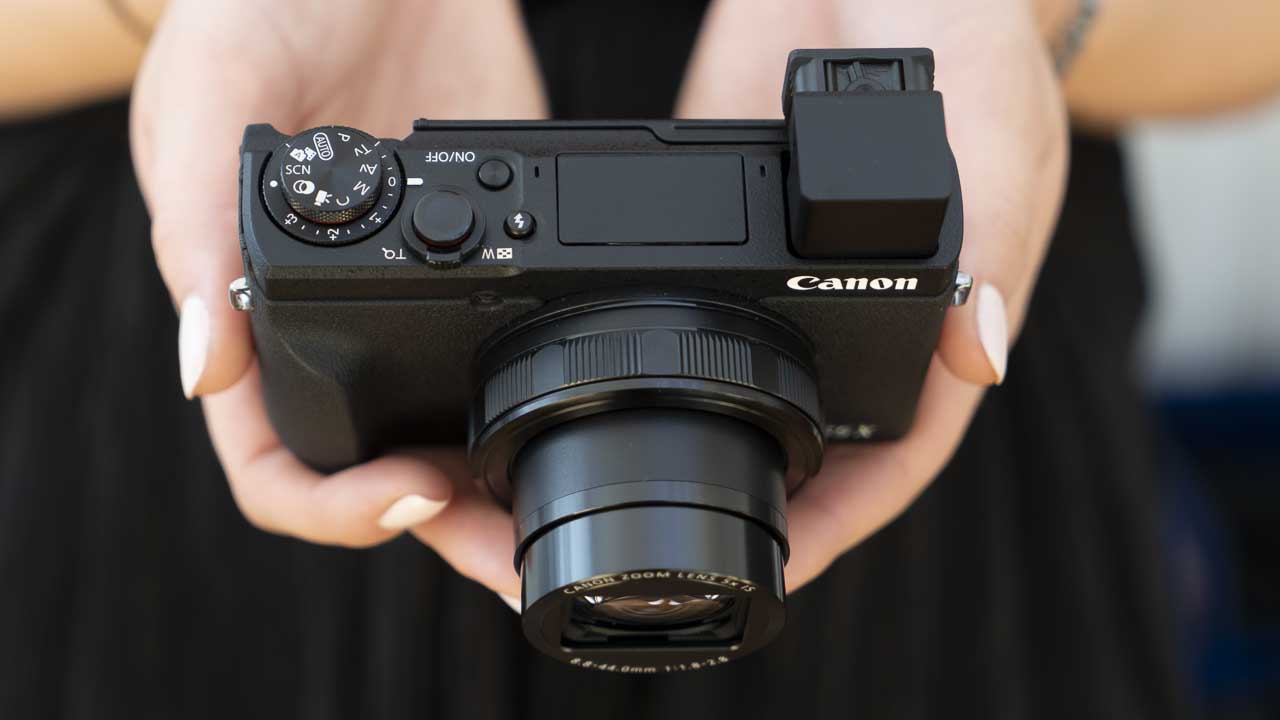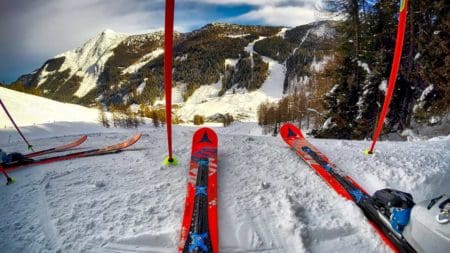It’s hard to find more spectacular scenery than high mountains in the winter. So it’s only to be expected that you’ll want to take a few photographs while you’re skiing. And with luck, you’ll capture an image that you want to hang on your wall or turn into a Christmas card.
But that’s not all you’re likely to want to photograph when you’re skiing. You’ll need a few shots of your slick moves as well. And maybe a video or two to really show off what you can do.
In this guide, we’ve gathered together a list of the best cameras for skiing, either shooting stills, or video, or both. If you shoot with a GoPro, don’t also miss our guide on how to GoPro skiing on your next holiday. For a deeper dive into the many different camera types and features available, check out our range of camera buying guides.
Canon PowerShot G5 X Mark II

Specification
- Camera type: Compact
- Sensor: 20.1Mp 1-inch type Stacked CMOS
- Lens: 24-120mm (35mm equivalent) f/1.8 – f/2.8
- Viewfinder: 0.39-inch type 2,360,000-dot OLED
- Screen: 3-inch 1,040,000-dot tilting touchscreen
- Autofocus system: AiAF (31-point, Face Detection or Touch AF with Object and Face Select and Track), 1-point AF (any position or fixed centre)
- Sensitivity range: ISO 125-12,800 expandable to ISO 25,600
- Dimensions: 110.9 x 60.9 x 46mm
- Weight: 340g with battery and memory card
This is one of my favourite compact cameras of recent times. First up, it has a 1-inch type sensor with a stacked design to get more from its 20.1Mp pixels. It and the process combine to ensure high-quality stills and 4K video.
Secondly, at 24-120mm the effective focal length range of the lens is really versatile. It’s wide enough for landscapes but has good telephoto reach for framing details and capturing nice portraits.
Further good news is that the 3-inch 1,040,000-dot screen can be flipped up for selfie-shooting, and its touch-control is superbly implemented.
The icing on the cake is that there’s a pop-up viewfinder, so on bright, sunny days on the piste, you can still compose images.
£850
$899.99For
- Pop-up electronic viewfinder
- No cropping in 4K video mode
- Excellent blend of touch and button/dial control
Against
- No mic port
- Would be nice if the ND filter were stronger
GoPro Hero11 Black

Specification
- Imaging Sensor: 1/1.9-inch 8:7 aspect ratio
- Max Resolutions and framerates: 5.3K60, 4K120, 1080p240
- Color depth: 10-bit
- Image Stabalisation: HyperSmooth 5.0 and 360º Horizon Lock
- Touch Screen display: Yes
- Photo reolsution: 27mp
- Auto tagging of footage: Yes
- Enduro battery: Included
- Dimensions: 71.8x33.6x50.8mm
- Weight: 154g
When you think about capturing action, there’s one camera brand that springs to mind, GoPro. The GoPro Hero11 Black is the latest flagship action camera from the American brand.
In terms of video quality, the Hero10 Black has its competitors beaten. And with this 11th iteration of the best action camera you can buy, GoPro has improved video and image quality even further by introducing a larger sensor.
The Hero11 Black also has HyperSmooth 5.0, the latest incarnation of GoPro’s superb in-camera stabilisation system. If you’ve not seen it in action, you’ll be amazed.
The headline video resolution is 5.3K at 60fps, which means you can even slow it down. However, it can also shoot 4K video at 120fps, which can add some serious slow-mo drama to your videos.
Handling-wise, the GoPro Hero11 is simple to use and it’s waterproof without a housing. That’s very useful in the mountains.
£499
$499For
- Great quality video
- Excellent stabilisation and horizon correction
- 4K 120p video for slow motion creation
Against
- Doesn't make a significant step-up from Hero10 Black
- Can be hard to open the battery compartment
- First time connection with a smartphone can be very frustrating
DJI Pocket 2

Specification
- Video Resolution: 4K @ 24/25/30/48/50/60fps, 2.7k and 1080p @ 24/25/30/48/50/60fps
- Sensor: 1/1.7-inch CMOS
- Pixel count: 64Mp
- Lens: FOV 93° f/1.8 Format equivalent: 20 mm
- Electronic Shutter Speed: 8-1/8000 s
- Stabilization: 3-axis
- ISO Range: 16mp Stills and video ISO 100-6400, 64mp stills 100-3200
- Video Modes: Video, HDR, Video, Timelapse, Motionlapse, Hyperlapse
The DJI Pocket 2 is one of our favourite products. It’s basically a 16 or 64Mp 1/1.7-inch CMOS sensor inside a small camera that’s mounted on a motorised gimbal. That gimbal does a great job of balancing out much of the bounce, wobble and shake that’s an almost inevitable feature of any video that you shoot as you hurtle down the piste or chug uphill on a lift.
The Pocket can be used by itself, or you can connect it to a smartphone to give and bigger screen and an alternative means of control. Thanks to DJI’s Mimo app, you can also edit the video from the Pocket in just a few minutes, including adding a title, transitions and music.
The end results are great.
£339
$349For
- Ultra compact
- Amazing video and audio quality
- Mechanical stabilisation
Against
- Fiddly mobile connection
- Just another thing to carry
Olympus OM-D E-M5 Mark III

Specification
- Camera type: Mirrorless camera
- Sensor: 20.4Mp Live MOS Micro Four Thirds sensor
- Lens mount: Micro Four Thirds
- Processing engine: TruePic VIII
- Sensitivity range: ISO 64-25,600
- Autofocus system: Hybrid with 121 (all cross-type) phase-detection AF points
- Maximum continuous shooting rate: Mechanical shutter: 10fps with focus and exposure fixed at the start of the burst, 6fps with C-AF, Electronic Shutter 30fps and 10fps
- Max video resolution: C4K 24p at up to 237Mbps / 4K 30p, 25p, 24p at 102Mbps
- Live Bulb Shooting Options: Live Composite, Live Time, Live Bulb, Focus Bracketing, Focus Stacking, 50Mp High Res Shot modes
- Viewfinder: 2,360,000-dot electronic viewfinder
- Screen: Vari‑angle 3.0-inch 1,037,000-dot touchscreen
- Dimensions (W x H x D): 125.3 x 85.2 x 9.7mm
- Weight: 414g including battery and memory card, 366g body only
The OM-D E-M5 Mark III is Olympus’s most recent Micro Four Thirds camera and it has the best image stabilisation system that we’ve seen to date. It transforms what should by rights be shakey, nauseating video into something smooth and watchable, which is perfect if you want to capture some downhill action.
Helpfully, at 125.3 x 85.2 x 9.7mm the OM-D E-M5 Mark III won’t take up much space in your bag, and at 414g including the battery and memory card, it won’t weigh you down excessively either. What’s more, it’s weatherproof so if you should drop it in the snow or take a hit from a snowball, it should be fine.
In addition, the 20.4Mp Live MOS Four Thirds sensor captures great-quality images and the autofocus system is fast enough to keep up with fast-moving subjects.
£1100
$1199.99For
- Images full of detail
- Low noise at higher ISOs
- Superb stabilisation
Against
- Image quality can't quite match full-frame
- Dynamic range could be better
Sony A7R IV

Specification
- Camera type: Full-frame mirrorless
- Announced: 16th July 2019
- Sensor: 61MP BSI full-frame sensor
- Lens mount: Sony FE
- Autofocus system: Hybrid with 567 phase detection + 425 contrast detection AF points
- Continuous Shooting: 10fps burst shooting with full AF / AE Tracking
- Video: 4K video with S-Log2/3, HDR
- Sensitivity range: Still images: ISO 100-32000 (expandable to ISO 50 to ISO 102400) Movies: ISO 100-32000
- Viewfinder: 0.5 type 5,760,000-dot OLED
- Screen: Tilting 3-inch 1,440,000-dot touchscreen
- Storage: 2x SD/SDHC/SDXC UHS-II
- Battery: Rechargeable NP-FZ100 battery supplied, Life Stills: 530 shots (viewfinder) / 670 shots (LCD), Movies: 90mins (viewfinder) / 105mins (LCD)
- Dimensions (WxHxD): 128.9 x 96.4 x 77.5mm
- Weight: 665 g / 1lb 7.5oz with battery and SD card
Although it’s a full-frame camera, the Sony A7R IV only measures 128.9 x 96.4 x 77.5mm and it weighs 665g / 1lb 7.5oz with battery and SD card. Pair it with the Sony FE 35mm f/2.8 ZA Sonnar T Carl Zeiss and you’ve got a really compact camera system that delivers very high-quality images.
The 35mm lens is very compact, and it’s a great focal length for general photography. But with 61Mp the A7R IV offers plenty of scope for cropping when you want to concentrate on smaller details in the frame.
Sony leads the way for autofocus capability and the A7R IV’s 567-point Hybrid AF system is superb. It keeps up with moving subjects with ease, whether you’re shooting stills at 10fps or 4K video.
Sony has also beefed-up the weatherproofing for the A7R IV in comparison to its predecessor. I’ve not had chance to test the A7R IV in more than a bit of drizzle so far, but the early signs are good.
While it’s an excellent camera, the A7R IV’s price is steep. If you’re tempted but want something a little more affordable, take a look at our Sony A7R III review.
£3500
$3500For
- Superb detail resolution
- Excellent autofocus system
- High-resolution electronic viewfinder
Against
- Limited use made the touch-control
- Tilting rather than vari-angle scree
- High price



